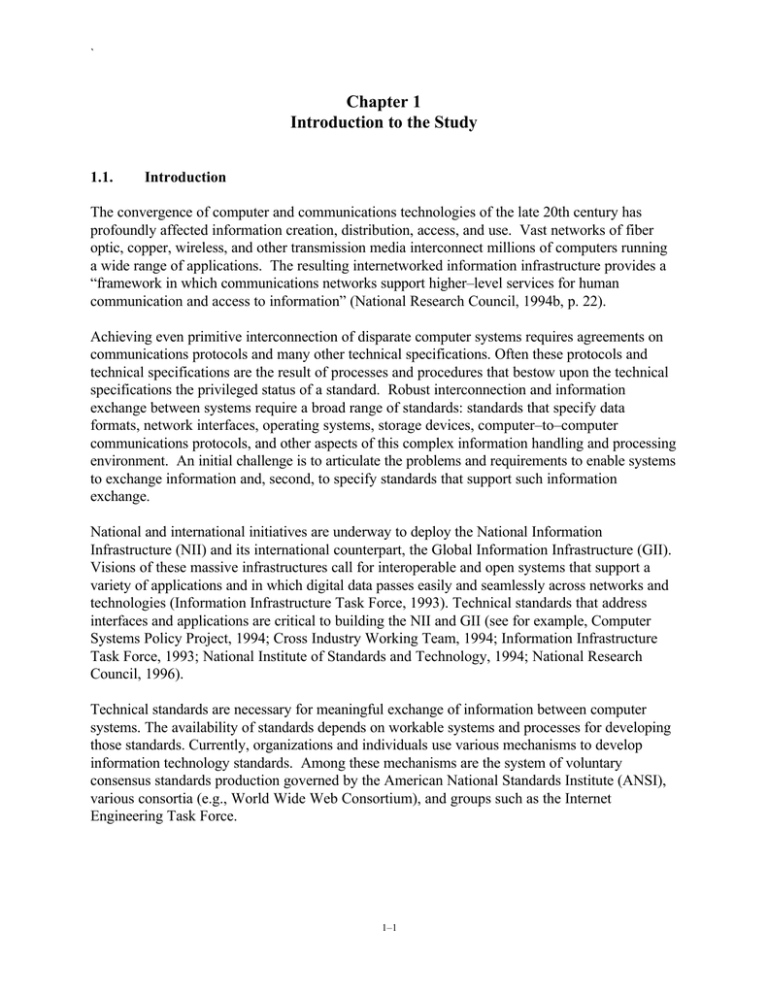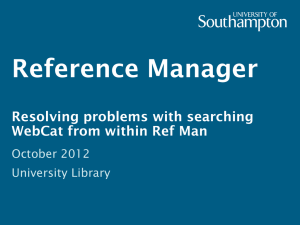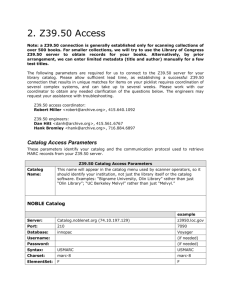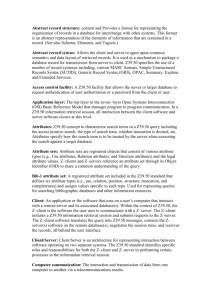Chapter 1 Introduction to the Study
advertisement

` Chapter 1 Introduction to the Study 1.1. Introduction The convergence of computer and communications technologies of the late 20th century has profoundly affected information creation, distribution, access, and use. Vast networks of fiber optic, copper, wireless, and other transmission media interconnect millions of computers running a wide range of applications. The resulting internetworked information infrastructure provides a “framework in which communications networks support higher–level services for human communication and access to information” (National Research Council, 1994b, p. 22). Achieving even primitive interconnection of disparate computer systems requires agreements on communications protocols and many other technical specifications. Often these protocols and technical specifications are the result of processes and procedures that bestow upon the technical specifications the privileged status of a standard. Robust interconnection and information exchange between systems require a broad range of standards: standards that specify data formats, network interfaces, operating systems, storage devices, computer–to–computer communications protocols, and other aspects of this complex information handling and processing environment. An initial challenge is to articulate the problems and requirements to enable systems to exchange information and, second, to specify standards that support such information exchange. National and international initiatives are underway to deploy the National Information Infrastructure (NII) and its international counterpart, the Global Information Infrastructure (GII). Visions of these massive infrastructures call for interoperable and open systems that support a variety of applications and in which digital data passes easily and seamlessly across networks and technologies (Information Infrastructure Task Force, 1993). Technical standards that address interfaces and applications are critical to building the NII and GII (see for example, Computer Systems Policy Project, 1994; Cross Industry Working Team, 1994; Information Infrastructure Task Force, 1993; National Institute of Standards and Technology, 1994; National Research Council, 1996). Technical standards are necessary for meaningful exchange of information between computer systems. The availability of standards depends on workable systems and processes for developing those standards. Currently, organizations and individuals use various mechanisms to develop information technology standards. Among these mechanisms are the system of voluntary consensus standards production governed by the American National Standards Institute (ANSI), various consortia (e.g., World Wide Web Consortium), and groups such as the Internet Engineering Task Force. 1–1 Evidence in the literature, however, points to major difficulties and problems in producing information technology standards. As one example, a report from the Organisation for Economic Co–operation and Development (Committee for Information, Computers and Communications Policy, 1991, p. 7) stated: the acceleration of technological advances in the IT [information technology] area has put the standardization system under pressures which may often be contradictory: the production of standards become more urgent, but consensus between the interested groups may be more difficult to achieve because of uncertainties and the magnitude of vested interests. Furthermore, caution is required to formulate standards which will evolve in line with future developments. Although there is a critical need for technical standards, understanding the processes for creating these standards appears deficient. Little in the way of systematic, empirical research on the development of information technology standards exists. A number of writers have pointed to reasons why these essential standards are difficult to create. Beyond the descriptions of the official standards procedures and anecdotal evidence about some of the problems, however, we have little understanding of entire process of “standards development.” While a number of researchers have conducted empirical research, the efforts are often limited to aspects of standards development but have contributed insights into the economic factors, the formal rules and procedures, and leadership in standards committees (e.g., Farrell & Saloner, 1985; Lehr, 1992; Spring, et al., 1995; Weiss, 1993). None of the research has attempted an empirically– or theoretically–based, holistic understanding of an entire standards development process. 1.2. Study Goals, Objectives, and Research Questions This study addresses the lack of a holistic understanding of the complex of activities, entities, processes, and forces that comprise standards development. The basic question motivating the researcher was: “Why is the development of voluntary consensus standards for information technology problematic?” Addressing this question implied a need to develop an understanding of the processes by which such standards are created. There are calls for improving information technology standards development. Without an empirical and conceptual understanding of the complex and multifaceted standards development process, however, changes and reforms to existing process may turn out to be “solutions” to the “wrong problems.” To develop an understanding of standards development, the study investigated the creation of one specific standard currently used in the distributed, networked information environment. ANSI/NISO Z39.50: Information Retrieval (Z39.50) Application Service Definition and Protocol Specification (National Information Standards Organizations, 1995) is an American National Standard that defines a standard protocol by which two computers to communicate for the purpose of information retrieval. Specifically, Z39.50 supports information retrieval in a distributed, client and server environment where a computer operating as a client conducts information retrieval transactions 1–2 on a remote computer acting as an information server. It provides a consistent view of information from a wide variety of sources and offers client implementors the capability to integrate information from a range of databases and servers (for background information on Z39.50, see Moen, 1995). A case study of Z39.50 provided an opportunity to investigate a long–term standards development activity. Formal Z39.50 development began in 1979 and this study follows the standard’s evolution through 1995. The focus of this study was the complex phenomenon of standards development that includes activities, procedures, processes, and various entities, constraints, and other forces operating at macro– and micro–levels. Standards development does not occur in a vacuum. At the macro–level of standards development are policy, organizational, political, economic, and other concerns that may influence the development of a particular standard (for an overview of these concerns, see Committee for Information, Computers and Communications Policy, 1991). A holistic understanding requires that a macro–level understanding be complemented by an examination of the activities and processes involved in writing and producing standards (i.e., the micro–level). Two complementary goals, a set of objectives, and three specific research questions provided overall guidance and direction for this study. Figure 1–1 lists the study’s goals, objectives, and research questions. ___________________________________________________________ Figure 1–1 Study Goals, Objectives, and Research Questions Study Goals • G1: Document the development of Z39.50 • G2: Develop a holistic understanding of Z39.50 development Study Objectives • O1: Identify and describe the context within which Z39.50 development occurred and discover the important factors that enabled or constrained its development • O2: Revise and refine the preliminary conceptual model of information technology standards development to reflect Z39.50 development • O3: Develop working hypotheses from Z39.50 development to test and explore in other information technology standards development efforts Research Questions • RQ1: What are the activities, entities, processes, and forces, and the contexts that influenced, enabled, or constrained Z39.50 development? • RQ2: What are the components of a systems–theoretic conceptual model that reflects Z39.50 development? • RQ3: What working hypotheses are warranted based on Z39.50 development to guide future research? ___________________________________________________________ The first Study Goal (G1) was to document the development of Z39.50. Chapter 4 presents a descriptive narrative detailing the various events, activities, and people involved with Z39.50 1–3 development over a 16–year period beginning in 1979 with the establishment of the formal standards committee and ending with the approval in 1995 of revised Version 3 of the standard. The second Study Goal (G2) was to develop a holistic understanding of Z39.50 development. Chapter 5 analyzes the reconstruction of Z39.50’s historical development presented in Chapter 4. The researcher used a systems–theoretic conceptual model as an analytical tool to identify essential features and factors that shaped Z39.50 evolution. He also revised the model, based on the data, to reflect Z39.50 evolution. 1.3. Justification for the Research and Study Benefits Technical standards are needed for achieving the visions of national and global information infrastructures and to realize effective and efficient information exchange within these infrastructures. While many commentators and participants criticize the formal voluntary consensus approach to standards development, there have been few models or methodologies proposed for conducting research on standards development. This study offers a methodological approach that allows the exploration, description, and analysis of the complex social and technical interaction that comprises standards development. The study demonstrates the utility of a qualitative/naturalistic research approach and case study method to gain a holistic understanding. The study provides important insights into the difficulty and complexity of developing a voluntary consensus standard for information technology. The analysis of Z39.50 development presented in this study demonstrates the utility of a systems model as an analytical tool. The researcher concluded, however, that the systems–based preliminary conceptual model (see Chapter 2) was inadequate in representing the dynamic and evolutionary character of Z39.50. The study resulted in a revised conceptual model that accounts for Z39.50 evolution and proposes two conceptual extensions to the systems approach that may have utility in subsequent research on standards development. Z39.50 was an appropriate standard for this study. Its development was a long–term effort. The researcher investigated Z39.50 development activities occurring first in the formal setting of the National Information Standards Organization (NISO) and since 1990, occurring within an emergent, informal, and non–sanctioned structure (i.e., the Z39.50 Implementors Group, ZIG). The standard’s development since 1990 through the ZIG and the Z39.50 Maintenance Agency offers an example of a major change in the standards development process to deal pragmatically with the problems and requirements implementors. The researcher also views Z39.50 as a revelatory case to the extent that it provided an opportunity to discover and describe problems that may be common to other information technology standards development efforts. This study contributes to an understanding of the formal voluntary consensus standards development process, since Z39.50 development occurred under the auspices of NISO, an ANSI– accredited standards organization. Such understanding is necessary if standards organizations are to make systematic and informed changes to their processes and procedures rather than in haphazard and reactive ways. Without understanding the complex phenomenon of standards 1–4 development, reforms may be introduced (e.g., using electronic mail with the hope that standards development can proceed more quickly) when in fact the actual problems may be of an entirely different order (e.g., not fully acknowledging that goals of standards development efforts may change over time). The study provides an empirical basis for organizations and individuals interested identifying factors that may affect standards development. The study’s findings highlight the complex interaction of forces and entities that may be involved in standards efforts, and they contribute to ongoing discussions concerning appropriate processes to produce timely and successful information infrastructure standards. 1.4. Study Methodology Given the lack of empirical research on standards development, the researcher intended this study as exploratory and descriptive research. Chapter 3 details the study’s research method and activities. The study focused on discovery, description, and a holistic understanding of Z39.50 during its 16–year evolution. The study employed a case study methodology that provided a methodological structure for a detailed examination and documentation of the activities, entities, processes, and forces, and their interactions during the development of the standard. The study used a naturalistic research approach (Guba, 1990; Guba & Lincoln, 1994; Lincoln & Guba, 1985). Naturalistic research is a qualitative research approach that “requires not the isolation of factual fragments from society, perhaps in order to analyze them quantitatively, but a participative immersion in the context under study and a healthy respect for the richness, density, and ambiguity of social life” (Sutton, 1993, p. 416). The focus of naturalistic inquiry is on understanding and not generalization, a focus on the idiographic (i.e., the particulars of the case) rather than the nomothetic (i.e., lawlike generalizations) (Lincoln & Guba, 1985, p. 42). The study used primarily qualitative data collection strategies, although when appropriate, quantitative data were collected. The study’s sources of data included: • • • Documentary evidence from the sixteen years of Z39.50 activities Interviews with participants and stakeholders in Z39.50 development Observation of Z39.50 standards development activities. At the outset of the study, the researcher proposed a preliminary conceptual model based upon a systems–theoretic perspective of standards development. Chapter 2 introduces the model and provides evidence for it from the literature on standards and standards development. The model guided the initial staged of the research and served as an analytical tool to examine Z39.50 development. The systems–theoretic approach, which acknowledges the interrelatedness among components of a system, supported the study’s orientation toward a holistic understanding. Such an approach illustrates that “the complex world of human beings cannot be fully captured and understood by simply adding up carefully measured and fully analyzed parts” (Patton, 1990, p. 81). 1–5 The research design was evolutionary in that the entire research effort could not be detailed in advance. The proposal for this study, however, provided a general map of the research activities. For this exploratory and descriptive study of Z39.50 development, a qualitative, naturalistic, case study approach was appropriate. The choice of this approach, however, has implications in terms of the limits of the study. 1.5. Scope of Study The study was limited to an investigation of the development of Z39.50. The researcher did not systematically compare and contrast this case with other standards development efforts. This study explored the Z39.50 as one instance of information technology standards development. Single– case studies provide a richness of data and can lead to a deep understanding of a phenomenon in a single context. Single–case studies such as this do not provide the basis for generalizability over all instances of the phenomenon. The working hypotheses derived through this study, however, can be tested in subsequent research. In addition, the study did not attempt to test the preliminary conceptual model. Instead, the study’s goal was to develop a model that could represent the evolution of Z39.50. Z39.50 development is an ongoing activity. This scope of this study, however, was temporally bound by the initiation of the standards effort in the late 1970s and the completion and approval of Version 3 of the standard in 1995. This 16–year period allowed the researcher to examine how the standard’s evolution moved through several phases. Z39.50 development included a range of activities, entities, processes, and forces, and contexts including: • • • • Initiation of the standards development effort Components and stages of the development of this standard Forces and pressures that affected the development of the standard (e.g., political, economic, technological, etc.) Stakeholders and other interested parties and their interaction. This was the terrain of standards development investigated by this study. 1.6. Structure of the Report This dissertation comprises six chapters. This first chapter provides a basic introduction to the study and briefly presents the motivation for the study, its focus, goals and objectives, research questions, and research approach. Chapter 2 provides a context for the research by examining the relevant literature on standards and standards development. The chapter offers background on standards and standards development processes to situate Z39.50 development in a broader context. In Chapter 2, the 1–6 researcher introduces the preliminary conceptual model and discusses the theoretical framework upon which the model is based. Chapter 3 addresses the research method, data collection, and analysis techniques used in this study. It describes the archival resources examined in developing the historical reconstruction of Z39.50 development and identifies the interviews and observations conducted by the researcher to gather data about historical and current activities related to Z39.50. Chapters 4 and 5 present the results of the research. Chapter 4 provides a historical reconstruction of the evolution of Z39.50. Primary source materials and documentary evidence such as minutes of meetings, reports, and correspondence formed the basis for the reconstruction. Chapter 5 contains a set of key findings from the research. Chapter 4 presents the story of Z39.50, and Chapter 5 reflects the next step in creating an understanding of Z39.50 development. The systems–based conceptual model served as an analytical tool to identify and categorize factors and forces that affected the development of the standard. The key findings provide a foundation for understanding why and how Z39.50 evolved. The chapter revisits the preliminary conceptual model, evaluates its utility in this study, and proposes significant extensions to the model to represent the case of Z39.50 evolution. Chapter 6 concludes this dissertation. It summarizes and further elaborates the implications of the findings from Chapter 5. In addition, the chapter identifies possible next steps in research on standards development by specifying a set of working hypotheses. 1.7. Summary This study demonstrates the challenges as well as opportunities for conducting research on complex and “messy” social and technological phenomena such as standards and their development. The researcher had assumed that standards development was a complex, multifaceted social process, yet he had the belief that it was a process that could be successfully studied and analyzed. The researcher demonstrated that qualitative/naturalistic research applied in a rigorous and systematic manner offers an approach to overcome what Schmidt and Werle (1992) view as difficulties in conducting research on standards development. They suggest that the “empirical reconstruction of standardization processes is confronted with difficult problems of gathering and interpreting ‘data’.... Thus, in the final analysis not so much the problems involved in theorizing about standardization but rather the empirical difficulties of grasping the ‘real world’ of standard–setting processes may turn out to be the main impasses to this on–going research process” (p. 326). In studying Z39.50, the researcher explored an important standard for information retrieval in the networked environment. Z39.50 is a complex computer communications protocol that supports an open systems environment and has a long and intense development history. Further, as Michael (Michael & Hinnebusch, 1995, p. 15) states, “Z39.50 is the single most important networking standard available today.” Through this case study, the researcher achieved an understanding of 1–7 one instance of the phenomenon of information technology standards development and lays a foundation for future research. 1–8



